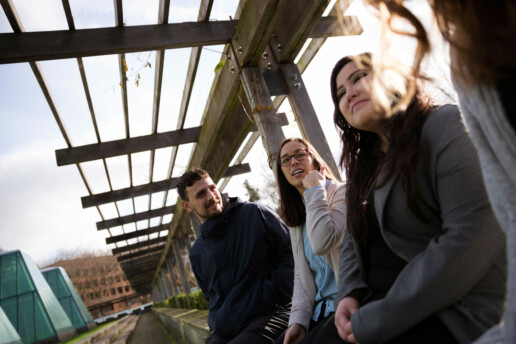Annual Results 2020 Diversity & Exclusion: Diversity Skills
This year for the first time, LSSSE introduced a set of questions focused on diversity and inclusion that supplement related questions from the primary survey. The Diversity and Inclusiveness Module examines environments, processes, and activities that reflect the engagement and validation of cultural diversity and promote greater understanding of societal differences. The 2020 LSSSE Annual Results Diversity & Exclusion report presents data about how diversity in law school can prepare students for the effective practice of law upon graduation. In our final post in this series, we will explore how law schools can teach skills to equip students to interact with people from different backgrounds.
Schools have a responsibility to not only admit and provide the resources to enroll a diverse class of students, but to impart the skills these students will need to be effective lawyers. Increasingly, the practice of law requires sensitivity to issues of race/ethnicity, gender, sexual orientation, and socioeconomic status. Law schools can empower students first by encouraging them to reflect on their own identities, and then supplying coursework on issues of privilege, diversity, and equity; while it is important for students to learn about anti-discrimination and anti-harassment, law schools should also equip them with the tools they will need to fight these social problems as attorneys and civic leaders.
Yet schools are, by and large, not preparing law students to meet these challenges and succeed as leaders. When students were asked how frequently they reflect on their own cultural identity, only 12% of White students do so "very often," compared to 50% of Native American students, 44% of Black students, and 34% of Latinx students. Even more alarming, over a quarter (26%) of White students never reflect on their cultural identity during law school. When we consider the intersection of raceXgender, an even more troubling picture emerges. A full 28% of White men and 25% of White women in law school never reflect on their cultural identity, compared to the 50% of Black women who do so "very often."
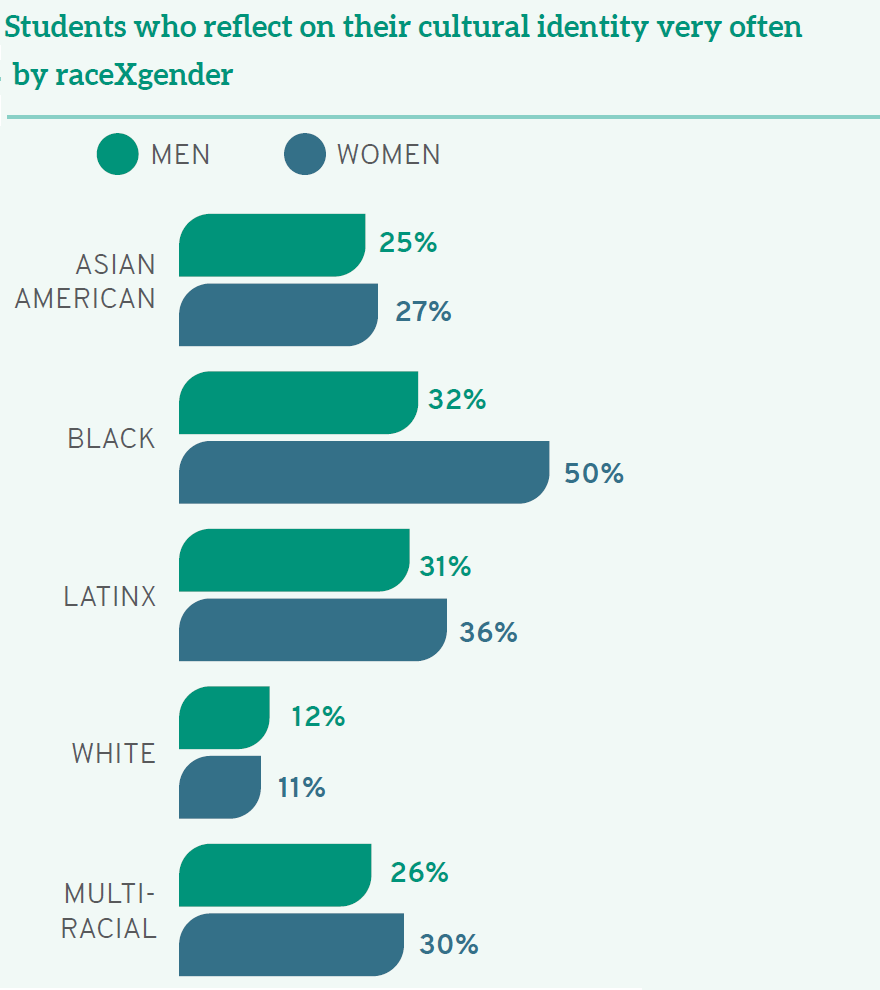
Students whose parents have less formal education are also more likely to reflect on their cultural identity, including 34% of those whose parents did not finish high school as compared to 16% of those who have a parent with a doctoral or professional degree. In sum, students with racial, gender, or class privilege are less likely to reflect on the benefits associated with their identity.
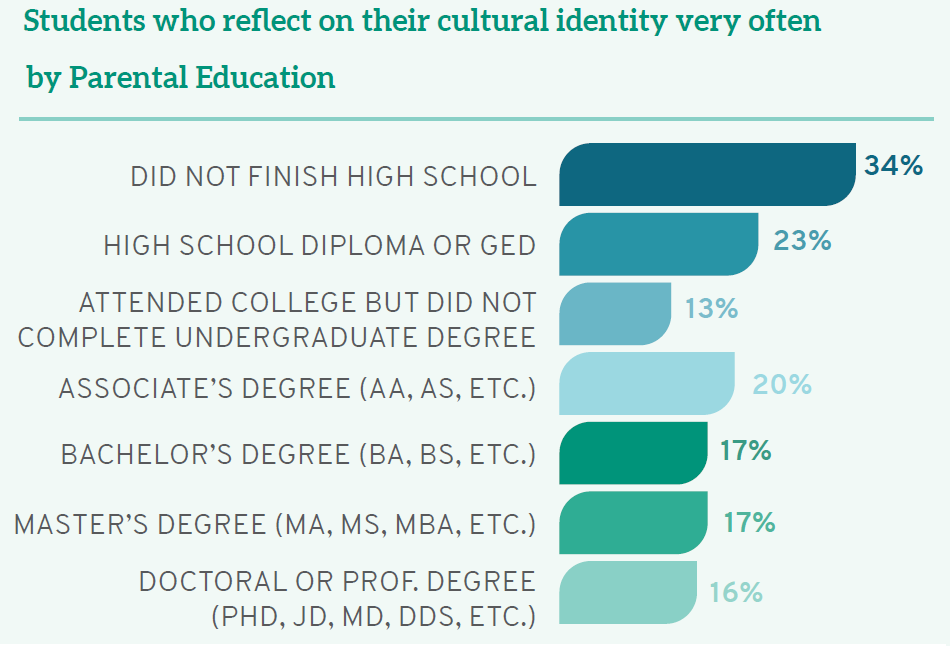
Even without self-reflection, students can nevertheless gather information about anti-discrimination and harassment policies. LSSSE data show that while White students see their schools as prioritizing this information, students of color do not agree at the same high levels. Similarly, men (31%) are more likely than women (23%) and those with another gender identity (11%) to believe their schools strongly emphasize information about anti-discrimination and harassment. Considering raceXgender, a full 27% of Black women see their schools as doing "very little" to share information on anti-discrimination and harassment, while 32% of White men believe their schools do "very much" in this regard.

Equally troubling, students from different backgrounds perceive institutional emphasis of various diversity-related topics in starkly divergent ways. Although White students believe that their schools emphasize issues of equity or privilege, respecting the expression of diverse ideas, and a broad commitment to diversity, students of color are less likely to agree. Students of color—including those who are Black, Latinx, Asian American, Native American, and multiracial—frequently note and appreciate assignments or discussions of race/ ethnicity and other identity-related topics in the classroom; yet they are more likely than their White peers to report that schools place “very little” emphasis on diversity issues. Women are similarly more likely than men to believe their schools do “very little” to emphasize diversity in coursework. Furthermore, higher percentages of Black women report “very little” emphasis on equity or privilege (36%), respecting diverse perspectives (27%), and an institutional commitment to diversity (21%)— compared to high percentages of White men who believe their schools are doing “very much” in all three arenas (20%, 24%, and 34%, respectively). First-gen students are also more likely than their classmates whose parents completed college to note “very little” diversity coursework. Synthesizing these data, students who are traditionally underrepresented and marginalized—arguably the students who have the most personal experience with issues of diversity—see their schools as doing less to promote diversity and inclusion than those who are privileged in terms of their race/ethnicity, gender, and parental education.

As part of a broad curriculum that sets up students for their future practice, law schools should teach students diversity skills—a set of skills that facilitate success in our increasingly globalized society, ranging from personal reflection to the tangible tools lawyers can use to combat discrimination. Law schools that succeed at these diversity-related endeavors will be preparing our nation’s newest lawyers to meet the full range of challenges ahead.
Guest Post: Connections and Community in Distanced Classrooms
Guest Post: Connections and Community in Distanced Classrooms
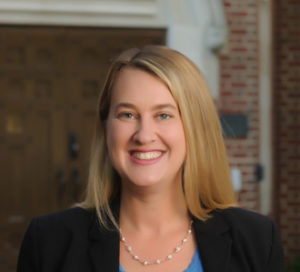 Jessica Erickson
Jessica Erickson
Professor & Associate Dean for Faculty Development
University of Richmond School of Law
Law faculty put significant thought into designing courses. We draft learning objectives, carefully craft assessments, and consider how to engage students inside and outside of the classroom. When law school courses suddenly moved online, many faculty had to think about a new aspect of course design how to build connections in classrooms where students were remote. Even in classes that were able to meet in-person, many of us found it difficult to develop a classroom community when students were in masks and seated six feet apart.
When we could no longer have casual conversations with students after class or in the hallways, many of us realized just how crucial these connections are for our students and for us. In this blog post, I discuss the importance of relationships to student learning and outcomes, as well as how to develop these relationships in online, hybrid, or physically distanced classes.
- The Importance of Relationships
Connections and community are essential to student learning. As I have previously discussed, research from undergraduate institutions shows that a sense of community is associated with increased motivation, greater enjoyment of classes, and more effective learning. Crucially, data from the Law Student Survey of Student Engagement (LSSSE) shows that these connections matter to law students as well. LSSSE data has been used to examine both the inputs and outputs of law students’ sense of belonging. Using LSSSE data, we can gain insight into what causes law students to feel a sense of belonging (inputs) and the impact that a sense of belonging has on law students’ performance in law school and their career (outputs).
Starting with inputs, LSSSE’s 2018 report Relationships Matter surveyed more than 18,000 students at 72 law schools. The report concludes: “Relationships with faculty, administrators, and peers are among the most influential aspects of the law student experience. These connections deepen students’ sense of belonging and enhance their understanding of class work and the profession.” Connections, in other words, are key when it comes to fostering law students’ sense of belonging. Law schools are doing a good job at developing connections, with 83% of students stating that they have at least one faculty member whom they could approach for advice or guidance.
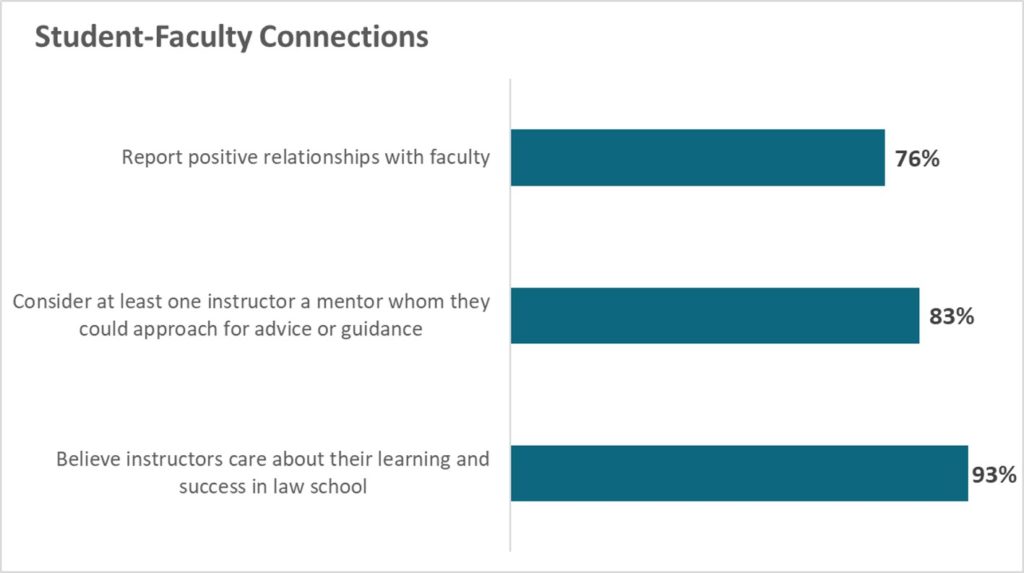
When it comes to outputs, we can look at research by Professor Victor D. Quintanilla using LSSSE data. He found that a sense of belonging significantly predicted three key outputs – (1) students’ overall experience in law school, (2) whether they would choose to go to law school again, and (3) their academic success (i.e., law school GPA). Moreover, not only does a student’s sense of belonging predict academic performance, but the impact was even greater than other commonly used predictors such as undergraduate GPA and LSAT scores. This means that, even if students come to law school with different academic backgrounds, we can help close this gap by fostering our students’ sense of belonging.
Unfortunately, the research also suggests that building this sense of community is much harder in online or hybrid courses, which most of us who taught this past fall can probably confirm. Now we need to think even more deliberately about how to develop these connections in our classes.
- Building Relationships in Remote or Physically Distanced Classrooms
This past summer, I wrote two blog posts, one with suggestions on how faculty can connect with students in these new learning environments and the other with suggestions on how faculty can help students connect with each other. In this post, I want to reflect back on these strategies now that I have tried many of them with my own students.
First, I found office hours to be a key way to connect with students. I renamed my office hours “student hours” on the advice of a colleague, and I borrowed language from this same colleague to include in my syllabus: “I call these ‘student hours’ for a reason: they are for you. You should come to these student hours if you have a question about the course, but you can also just stop by to introduce yourself, ask any other questions, or talk about your law school experience. I want to get to know you!” At the start of each meeting, I talked with students about how law school was going, and it was a great opportunity to get to know them better.
I call these ‘student hours’ for a reason: they are for you. You should come to these student hours if you have a question about the course, but you can also just stop by to introduce yourself, ask any other questions, or talk about your law school experience. I want to get to know you!
Second, I used technology to connect with students individually. I asked each of my students to create their own Google Doc and share it with me, and they were required to compete short pre-class assignments in their Google Docs. I’ve used this strategy in the past, and found it to be a great way to make sure that students understand the reading. This semester, though, I set aside 1-2 hours before each class to include personal comments on each students’ assignments. I had 52 students across two classes, so it took a while, but it allowed us to connect more personally. I also gave them “Just for Fun” optional questions to include in their Google Doc where they could tell me their favorite board game or share a picture of their pet. I featured a few at the start of class, which was a fun way to personalize a class full of masked students. You can read more about my pre-class assignments here.
Third, several of my colleagues set up individual and small-group meetings with students. One colleague held individual “office hours” with each student. Another who taught a hybrid class met separately with all of her students who were fully remote. A third held online coffee breaks with 3-4 students at a time where the only rule was that they could not talk about course material.
Fourth, optional events allowed me to connect with students in a more relaxed way. In class, I was often preoccupied with the day’s material and all of the tech challenges of my hybrid classroom. In optional events, however, we could talk and connect in a lower-stakes way. I held an optional discussion about a Supreme Court oral argument. I also held review sessions and a Civil Procedure game night where students competed in an online kahoot! If you’ve never tried a kahoot!, I strongly recommend it. It was a great way to let students test their knowledge and have fun at the same time.
Finally, I created opportunities for students to connect with each other. Many faculty were not sure whether students could work in groups six feet apart and wearing masks. It turns out that students can work together pretty easily even under these circumstances. Although it was tempting to incorporate more individualized assessments to keep students separated, it’s important to give them opportunities to deepen their learning with each other. I sometimes felt like a middle school dance chaperone reminding students to stay an appropriate distance apart, but it was worth it.
The final thing I will add is that we need to be careful that our efforts to connect with students do not overwhelm them or us. It is tempting for these community-building exercises to be added on top of what we already ask our students to do in our courses. Now that we have some experience in these new classroom settings, we can be a bit more selective in what we choose to include and assess whether we need to scale back in other areas. At the end of the day, though, as LSSSE data has shown us, relationships matter, and we need to think about how to cultivate these relationships even in these unusual times.
Annual Results 2020 Diversity & Exclusion: Sense of Belonging
This year for the first time, LSSSE introduced a set of questions focused on diversity and inclusion that supplement related questions from the primary survey. The Diversity and Inclusiveness Module examines environments, processes, and activities that reflect the engagement and validation of cultural diversity and promote greater understanding of societal differences. The 2020 LSSSE Annual Results Diversity & Exclusion report presents data about how diversity in law school can prepare students for the effective practice of law upon graduation. In this post, we explore how sense of belonging at law school varies among students from different backgrounds.
Scholarly research indicates that students who have a strong sense of belonging at their schools are more likely to succeed.1 Generally, belonging refers to feeling like part of the institutional community, fitting in, and being comfortable on campus.2 Using a number of separate indicators, LSSSE data on diversity and inclusiveness show that White students are more likely to have a strong sense of belonging than their classmates of color. For instance, when asked whether they feel they are "part of the community at this institution," a full 31% of White students strongly agree—though lower percentages of students of color do, including only 21% of Native American and Black students. Even more problematic when considering the importance of building an inclusive community: women of color are more likely than men from their same racial/ethnic backgrounds to feel that they are not part of the campus community—including a whopping 34% of Black women law students nationwide. First-gen students also deserve greater support, as only 23% "strongly agree" that they feel like part of the community at their law school, compared to 31% of students whose parents have at least a bachelor’s degree.
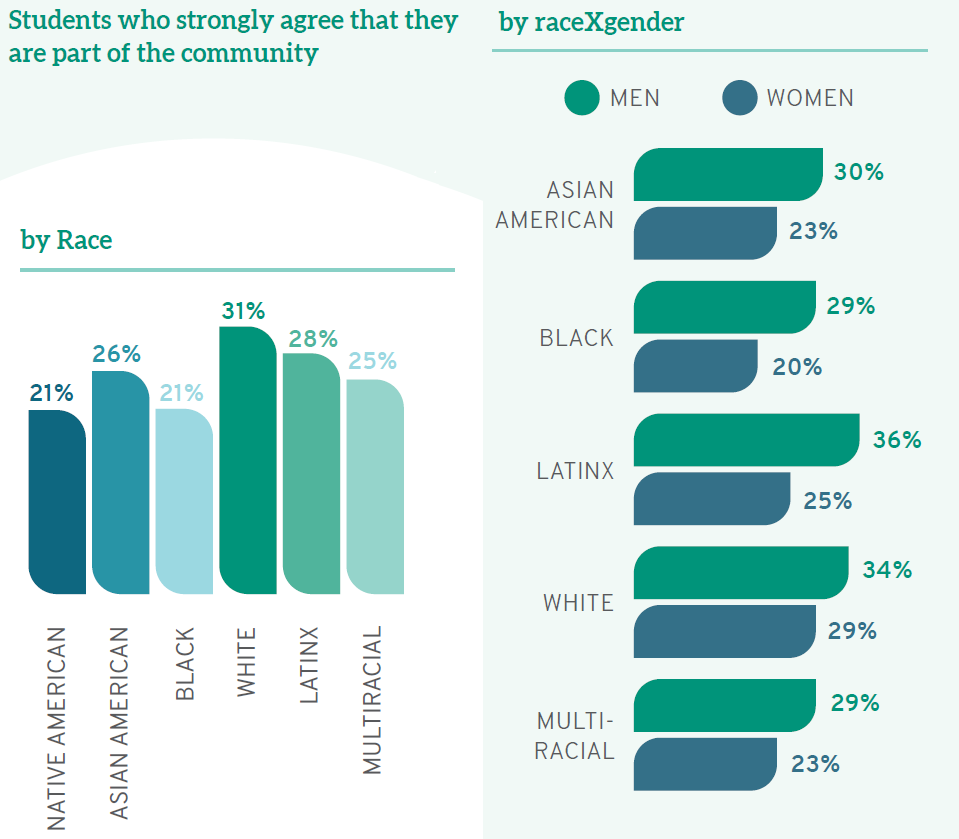
Students of color are also more likely than their White classmates to think their schools do "very little" to ensure students are not stigmatized based on various identity characteristics, including race/ethnicity, gender, religion, and sexual orientation. While only 9.3% of White students agree, 14% of Native Americans, 18% of Latinx students, and a full quarter (25%) of Black students believe their schools do "very little" to emphasize that students are not stigmatized based on identity. Similarly, 11% of heterosexual students think their schools do only "very little" to avoid identity-based stigma; conversely, 20% of gay students, 16% of lesbians, 15% of bisexual students, and 19% of those who identify as another sexual orientation see their schools as doing "very little" in this regard. Taken together, these findings suggest that those most likely to suffer stigma are also those most likely to think their schools do very little to protect them.
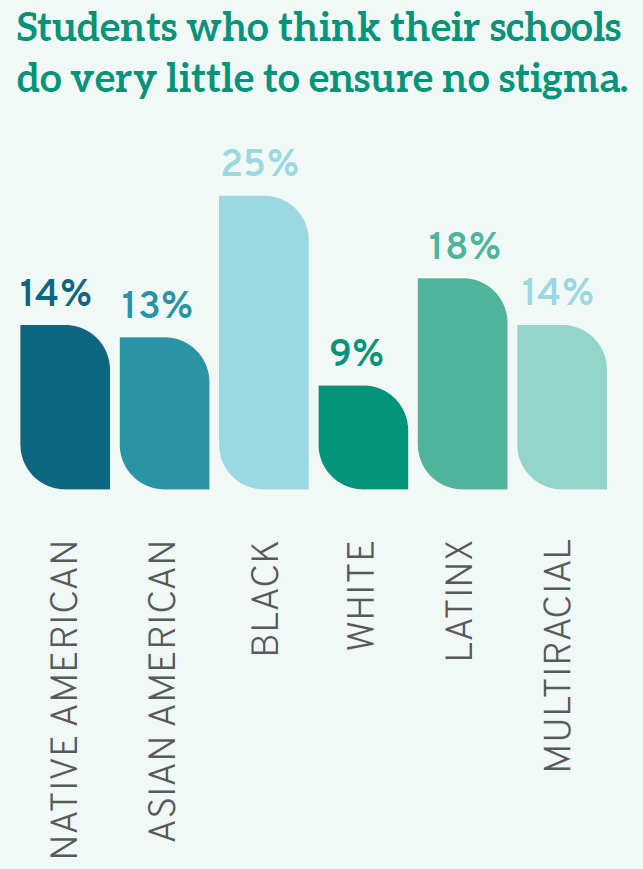
White students are also more likely than those from other backgrounds to be comfortable being themselves on campus, with only 12% noting they are not. Yet one out of every five (21%) law students who is Native American, Black, or Latinx notes that they do not "feel comfortable being myself at this institution."
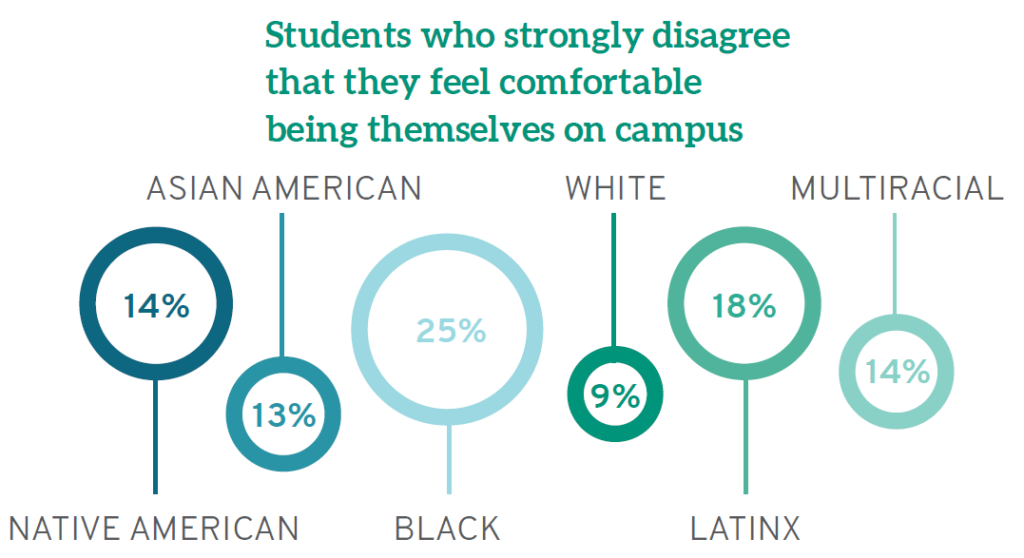
There are also disturbing disparities when considering parental education—a strong proxy for family socioeconomic status. Being comfortable on campus increases almost in lockstep with increases in parental education; a full 32% of law students whose parents did not finish high school are uncomfortable being themselves on campus, compared to just 12% of those who have a parent with a doctoral or professional degree.
The overarching theme from this report is that those who are most affected by policies involving diversity—the very students who are underrepresented, marginalized, and non-traditional participants in legal education—are the least satisfied with diversity efforts on campuses nationwide. Nontraditional students remain marginalized on campus, left out of the community, devalued, and underappreciated. The solution is clear: institutions should place greater emphasis on valuing students from all backgrounds, creating an inclusive community, and integrating diversity into the curriculum. With that foundation, law schools can prepare students to interact in meaningful ways with diverse clientele, to first recognize and then resist instances of discrimination or harassment, and to meet the many challenges they will confront in their roles as lawyers and leaders.
1 Kuh, G. D., Kinzie, J., Buckley, J. A., Bridges, B. K., & Hayek, J. C. (2006). What matters to student success: A review of the literature (ASHE Higher Education Report). San Francisco, CA: Jossey-Bass.
2 Strayhorn, T. L. (2018). College students’ sense of belonging: A key to educational success for all students. New York, NY: Routledge.
Annual Results 2020 Diversity & Exclusion: Institutional Support for Diversity
This year for the first time, LSSSE introduced a set of questions focused on diversity and inclusion that supplement related questions from the primary survey. The Diversity and Inclusiveness Module examines environments, processes, and activities that reflect the engagement and validation of cultural diversity and promote greater understanding of societal differences. The 2020 LSSSE Annual Results Diversity & Exclusion report presents data about how diversity in law school can prepare students for the effective practice of law upon graduation. In our next three posts, we will highlight key findings from the report and suggest some areas for improvement.
Support for diversity in law school must begin with the institution. Yet many students of color do not see their campus as supportive of racial/ethnic differences. Almost a quarter (23%) of Black law students nationwide say their schools do "very little" to create a supportive environment for race/ethnicity, compared to just 6.8% of White students. At the opposite end of the spectrum, 32% of White students believe their schools do "very much" to support racial/ethnic diversity, compared to only 18% of their Black classmates. Men (37%) are also more likely than women (26%) and those of another gender identity (7.5%) to believe their campus is very supportive of racial/ethnic diversity. Even more dramatic are intersectional identity findings, as a full 26% of Black women— more than any other raceXgender group—see their schools doing "very little" to create an environment that is supportive of different racial/ethnic identities, as compared to just 5.5% of White men (while 72% of White men believe their schools do "quite a bit" or "very much" in this arena).

Men are also more likely to see their campus as a "supportive environment for gender diversity," with 39% believing this "very much" as opposed to 27% of women students, and only 9% of students who identify as another gender identity. Furthermore, White students as a whole (33%) see the campus as very supportive of people of different genders, compared to 21% of Native Americans and Black students. Again, the views of White male students differ significantly from most others with a full 40% seeing their campus as very supportive of gender difference. In short, women as well as others from less privileged groups do not see their schools as particularly supportive of gender inclusivity.
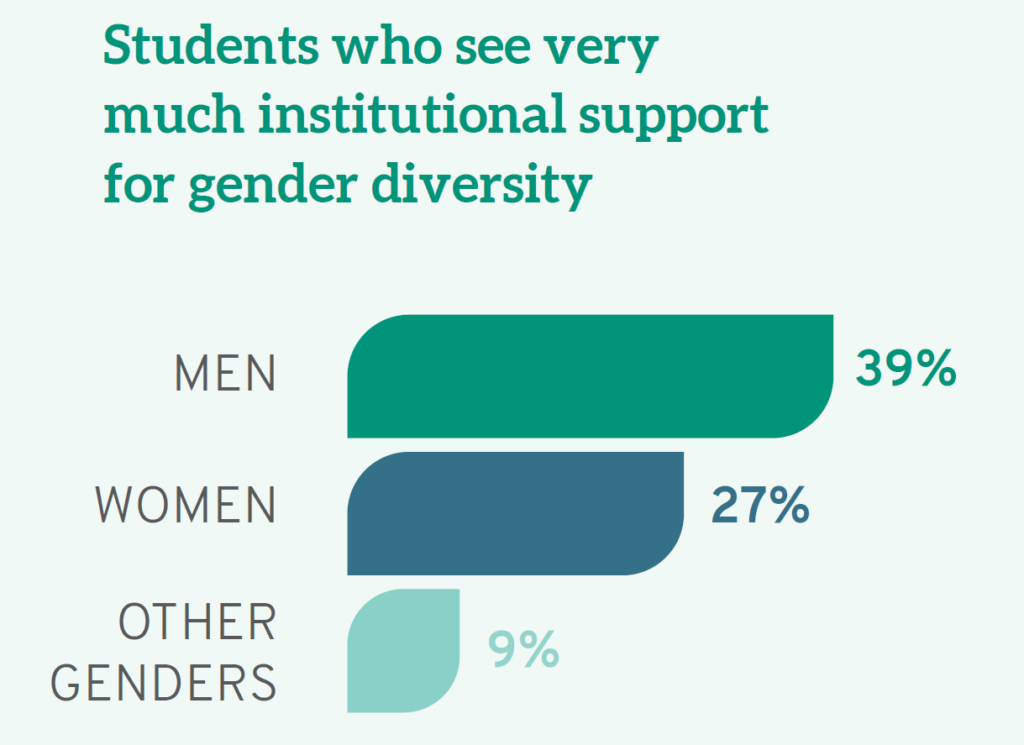
Not surprisingly, given the relative lack of support they see for racial/ethnic and gender diversity on campus, women and students of color also believe their schools are less invested in them as individuals. When asked whether they "feel valued" by their law school, a full 30% of men "strongly agree" compared to only 24% of women and 21% of those who identify as neither male or female. Similarly, the racial/ethnic group most likely to "strongly agree" is Whites (28%). In fact, while Latinos, White men, and Black men "strongly agree" that they are valued at roughly equal rates, men feeling more valued than women is consistent across every racial/ethnic group. Furthermore, students who are the first in their families to earn a college degree, often called "first-gen" students, feel less valued by their institution: a full third (33%) note they do not feel valued, compared to a quarter (25%) of others, which is also a significant proportion of law students overall.
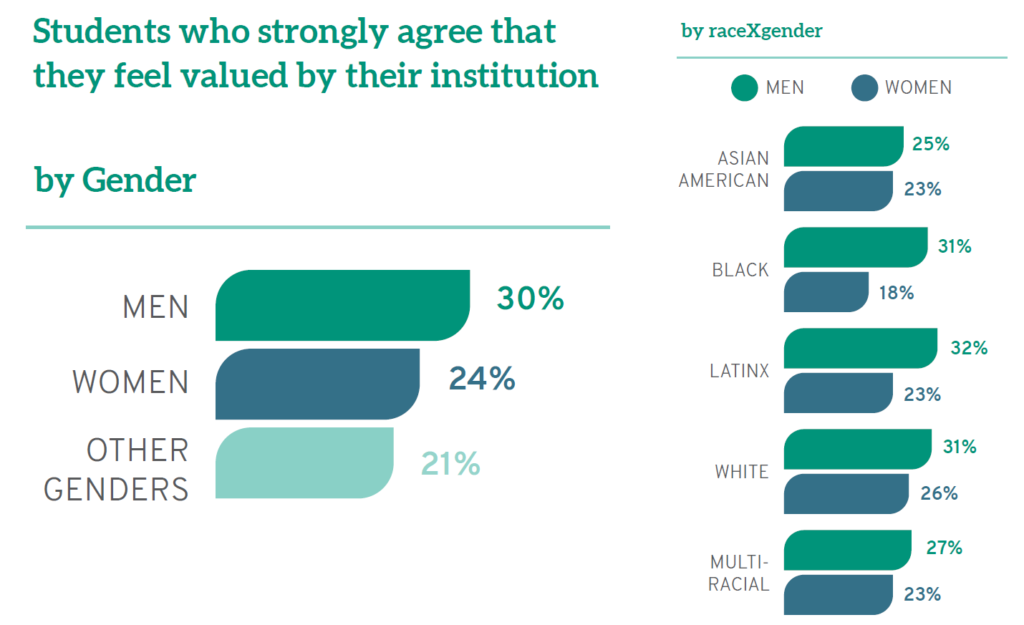
Institutions can put mechanisms in place to foster community among those on campus, regardless of their background or experiences. Finding this common ground helps all students understand that they belong and that others who may be different should be equally welcome. Again, White students are most likely to believe their institution emphasizes the importance of "creating an overall sense of community among students." While 28% of White students think their schools do this "very much," smaller percentages of students of color feel similarly. Even more disheartening, 18% of Black students and 14% of Latinx students think their schools do "very little" to foster community.
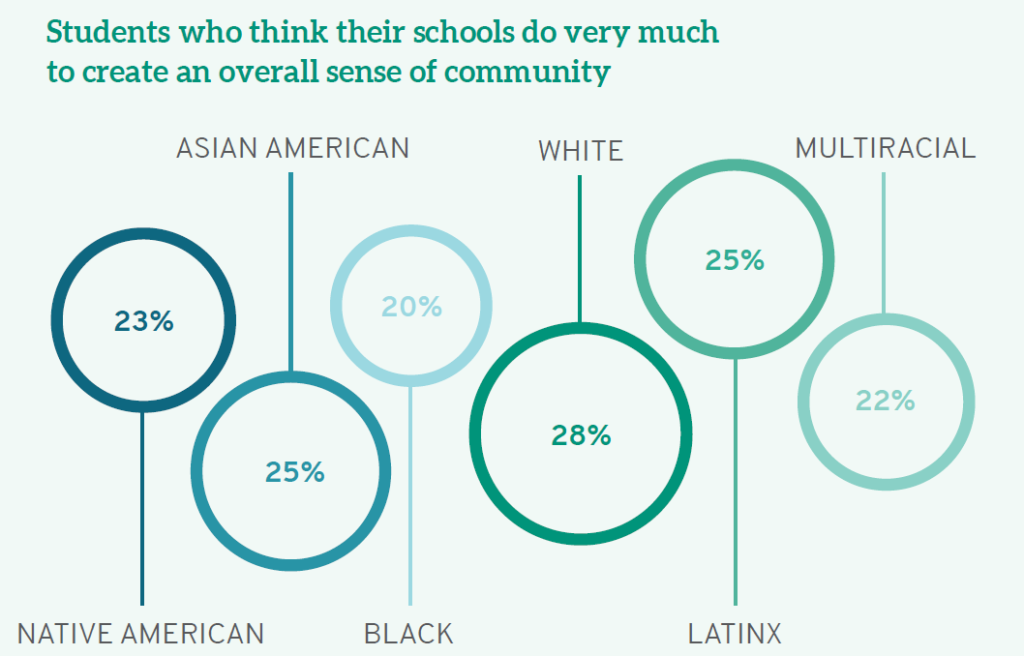
Many law schools have made concerted efforts to add student diversity to their campuses. But once students enroll, we owe it to them to provide a safe and welcoming environment, one where they feel valued, where they can be themselves, where they acquire the tools they need to succeed in the workplace, and where they can thrive. Admitting and even enrolling more students of color, first-gen students, students who identify as LGBTQ, and women is not enough unless that diversity is accompanied by inclusion. Law schools that want their students to succeed as future lawyers and leaders must commit to fostering a campus community where the most vulnerable and non-traditional are encouraged to reach their full potential, where faculty are expected to train students not only for the global marketplace but for the realities of American life, and where all students appreciate their own backgrounds, biases, and responsibilities to the profession.
Where do students get advice?
LSSSE’s optional Student Services module asks students about whether and how often they access academic and career services. Students draw from various sources to get advice about law school, legal education, and their future careers. Here, we look at the most commonly selected meaningful sources of advice for students and examine how patterns of advice-seeking change as students progress through law school.
Advice about Academic Plans
Faculty or staff not formally assigned as an academic advisor are the most common meaningful source of advice about academic planning. Over 40% of LSSSE respondents rely on these personal relationships that they develop with the law school professionals around them. Formal academic advisors –those assigned and those available to any students – are the second and third most commonly used sources of advice and were selected by 26% and 23% of students, respectively. About 22% of students consider websites, catalogs, or other published sources to be meaningful sources of advice about academic plans, and roughly one in five consulted family members. Only 14% of respondents did not seek academic advice from anyone during the current school year.
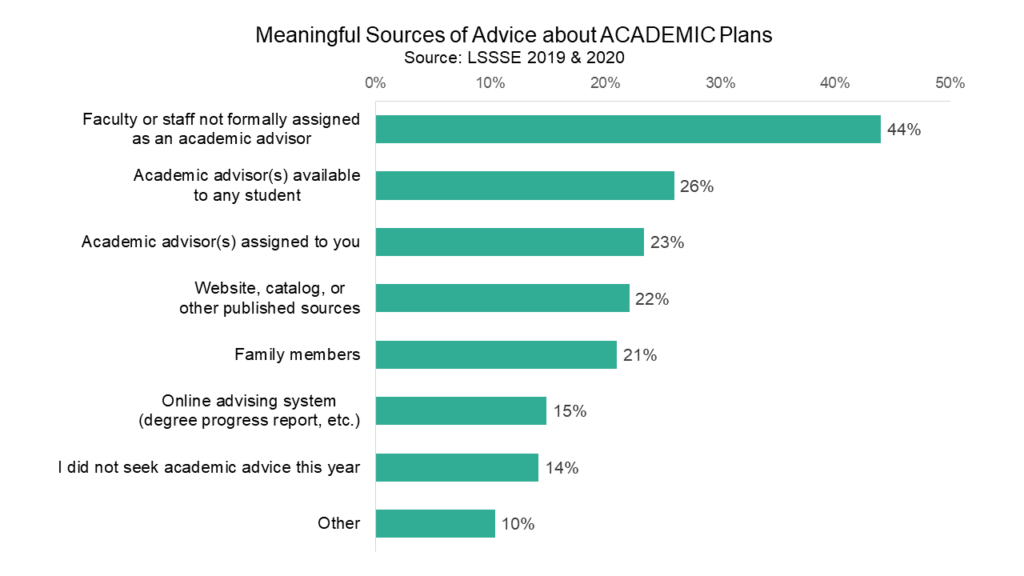
Students appear to rely less on assigned academic advisors as they progress through law school. Roughly one-third of 1L students say their assigned academic advisor was a meaningful source of advice, but only 15% of 3L students feel the same way. Perhaps unsurprisingly, 3L students were slightly less likely to seek academic advice than 1L and 2L students.
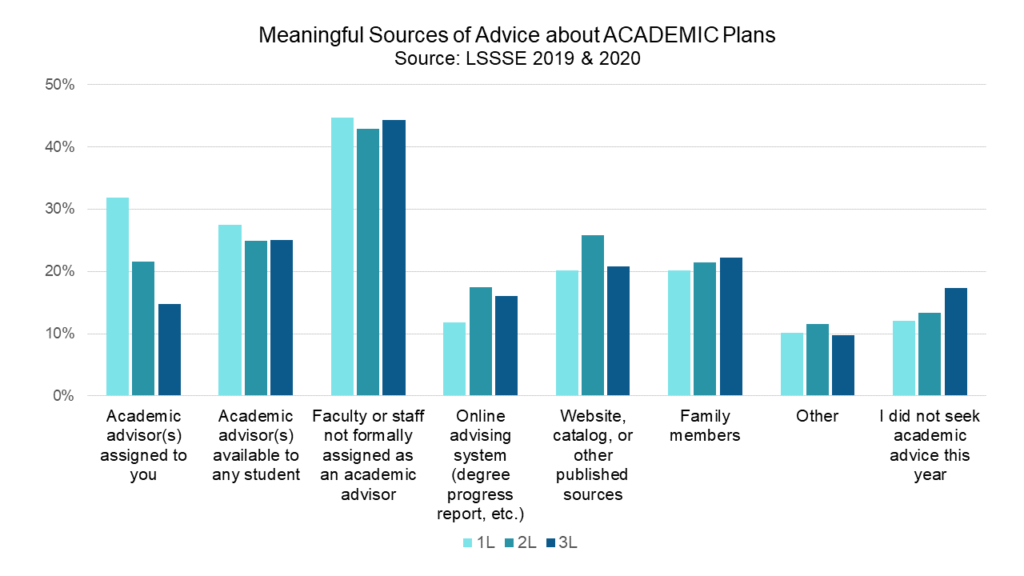
Advice about Career Plans
The ranking of meaningful sources of advice about career planning is remarkably similar to the ranking for advice about academic planning. Students highly value their relationships with law school faculty and staff when it comes to seeking career advice, ranking faculty or staff not formally assigned as a career advisor highest (38%), followed by career advisors available to any student (35%) and then assigned career advisors (27%). Interestingly, students were equally likely to select family members and assigned career advisors as meaningful sources of career advice. Twelve percent of respondents did not seek any career advice during the current school year.
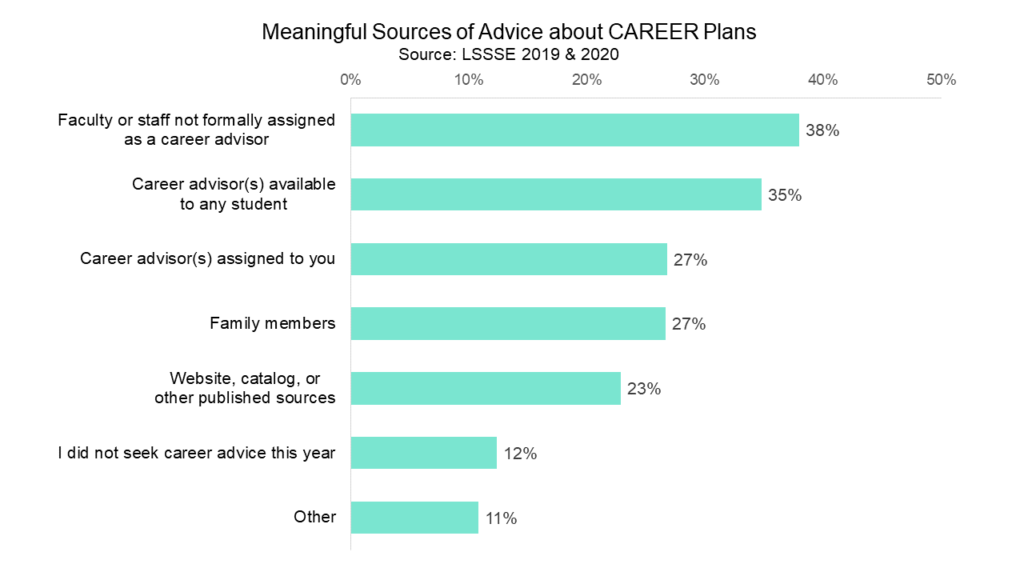
Students rely less on assigned career advisors as they progress through law school, which is similar to the pattern we saw for academic advising. However, the gradual decrease in reliance on formal career advising is somewhat mirrored by a gradual increase in reliance on advice from faculty or staff not formally assigned as career advisors. It would appear that as students refine their interests and form relationships with particular faculty or staff members, they start to rely more on personal relationships for career advising and less on relationships facilitated by the structure of law school.
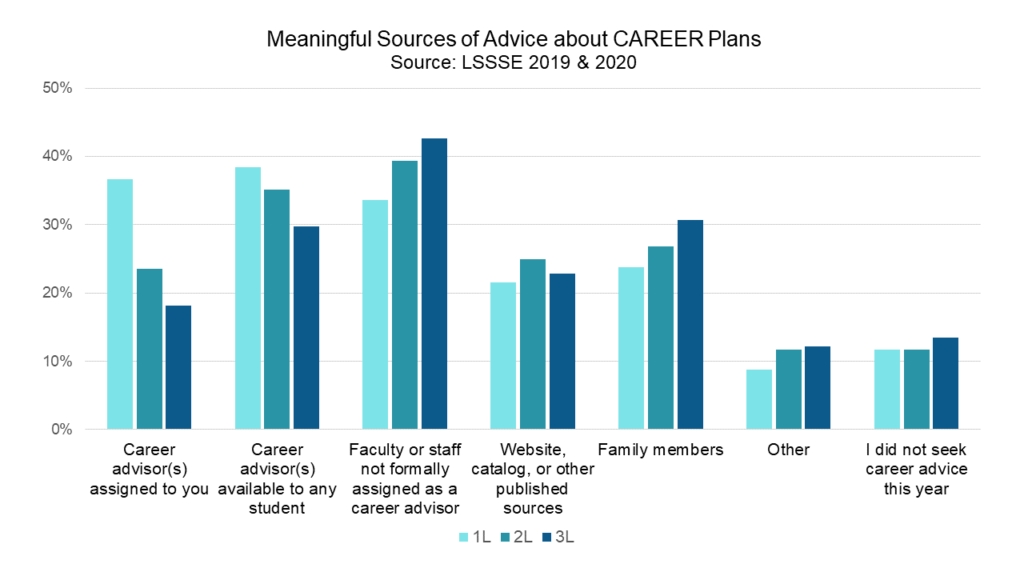
Learning How to Think Like a Lawyer
A legal education strives to teach law students how to "think like a lawyer." Although students may not articulate their reasons for attending law school in exactly this way, the rigor of the law school curriculum certainly challenges students to develop mental flexibility and analytical critical thinking skills. LSSSE asks students to comment on the degree to which their coursework emphasizes the development of several mental activities, namely memorizing, analyzing, synthesizing, making judgments, and applying ideas to new situations.
For each skill, more than half of law students indicated that their school emphasized developing that skill "quite a bit" or "very much." Analyzing the basic elements of an idea, experience, or theory was a nearly universal skill with ninety percent of 2020 LSSSE respondents reporting high emphasis in their coursework. Nearly as many (85%) said their law school placed a high emphasis on applying theories or concepts to new situations. About 83% felt that their coursework emphasized synthesizing ideas into new interpretations, and about 74% said the same for making judgments about the value of information. Memorization was the least emphasized mental activity, but still, 61% reported that their coursework places a high emphasis on memorizing facts, ideas, or methods.

1L students were slightly more likely than 3L students to say that their coursework emphasized the development of any given mental activity. This may be because 1L students are still in the process of adjusting to the rigors of a legal education and thus are more likely to see their educational challenges as formidable. It may also reflect the slight gradual decline in satisfaction and enthusiasm that occurs as law students progress through their degree programs.

Interestingly, the ranking of the five mental activities has remained constant since at least 2005. The longitudinal LSSSE data show a slight increase in the proportion of students who report that their schools place a high emphasis on each mental activity from 2005 to 2015 and then a slight decrease or plateau for each activity from 2015 to 2020.

Clearly, law school remains a challenging endeavor in that it places a strong emphasis on developing higher order mental faculties including analyzing the basic elements of an idea, experience, or theory, applying theories or concepts to new situations, and synthesizing ideas into new interpretations. Only a tiny percentage of students report that their legal education has placed very little emphasis on any of these skills. This suggests that law school is delivering on the promise to teach students how to think like a lawyer.
Guest Post: Issue (Blind)Spotting: Using Data to Understand Candidate Motivations to Attend Law School
Guest Post: Issue (Blind)Spotting: Using Data to Understand Candidate Motivations to Attend Law School
 Kristin Theis-Alvarez
Kristin Theis-Alvarez
Dean of Admissions and Financial Aid
Berkeley Law
Law school trains students to “issue-spot.” This means faculty test whether students can apply general knowledge to novel situations. The approach mimics the day-to-day practice of law: a client walks through the front door and you weave together their particular issue with your understanding of the applicable law in general. This isn’t unlike what admissions office representatives do when presenting to or advising prospective applicants. I’ve been in law school admissions since 2007, and have communicated with countless candidates, read thousands of applications, and partnered with a wide range of organizations that seek to increase access to legal education – so I have some sense of what applicants are asking. Against that backdrop (what admissions professionals believe is generally true about people interested in law school), our role is to offer advice based on specific candidate concerns. Where do we gain that broader understanding? LSSSE survey data is a good place to start if we want to move beyond anecdotal evidence. It can inform our understanding of candidate motivations for pursuing a law degree which then refines our outreach and recruitment messaging.
For example, through LSSSE data we learn that most students cite a desire to have a challenging and rewarding career as the most influential factor in their decision to enter law school. Over three-quarters of respondents indicated this was their primary motivation for seeking a law degree. So, it’s reasonable to suppose that when speaking to a room of prospective applicants, admissions professionals ought to emphasize career opportunities and employment outcomes. We might focus that message to highlight our school’s unique attributes (placing more emphasis on the percentage of our graduates working in public interest law or the number with federal clerkships, for example), but we’re always speaking to that core motivation.
Another significant motivator for law school attendance is the extent to which earning a law degree can lead not just to a rewarding career, but a lucrative one. LSSSE data tell us that many law students are pursuing the degree based on a desire to work toward greater financial stability. Taken together, the ability to get a job – and for that job to be one that provides financial stability – largely informs the decision to attend law school. This leads admissions professionals to frequently reference our school’s median starting salaries, and partially explains why we emphasize a ‘return on investment’ model to justify the cost of the degree.
LSSSE data also suggest that a desire to further one’s own personal academic development is a significant motivator for law school attendance. As a result, admissions professionals might emphasize our school’s leading programs, commitment to experiential education, research centers, and interdisciplinary education opportunities. We explain that law school is one of the few graduate programs where the strong possibility of professional and financial success intersects with that of individual growth. (More people might pursue a PhD in Classics if the academic job market looked different, and we might have fewer law students if instead of teaching through the casebook method we just handed everyone a list of rules to memorize.) We balance employment statistics with anecdotes about student skills being developed and deployed.
At the same time, less than half of LSSSE respondents report that an “inherent interest” in the curriculum or material they are learning is a source of motivation for them to work hard in law school. This may be why most law admissions professionals are not talking to eager undergraduate students about provisional remedies. It’s also why we generally explain a legal education as the opportunity to develop a diverse toolkit that can be used to solve complex problems, and not merely a content delivery method. Instead, more than half of respondents cite being competitive in the job market as a primary motivation to work hard in law school.
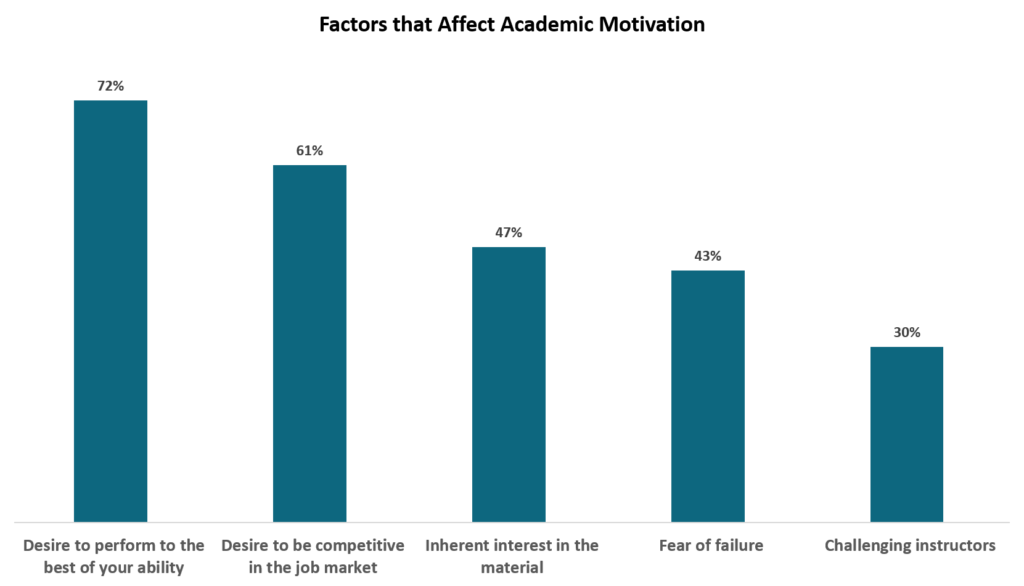
However, there are assumptions that admissions professionals might make when deploying student experience data in our work. Are we asking who we mean when we say “law students,” and who we imagine when we picture “prospective applicants”? More importantly, how do those assumptions lead to missed opportunities to reach candidates from backgrounds underrepresented in the applicant pool?
One way to illustrate this is to examine the differences between general LSSSE data about motivations for attending law school and what we know about the motivations for particular groups. Within the National Native American Bar Association (NNABA) Report “The Pursuit of Inclusion: An In-Depth Exploration of the Experiences and Perspectives of Native American Attorneys in the Legal Profession,” there is a section on the pipeline to law school and the legal profession with a forward written by Stacy Leeds, Dean Emeritus and Professor of Law at the University of Arkansas. This section of the NNABA Report indicates that Native American attorneys were more motivated to enter law school in order to give back to their tribe or Nation, to fight for justice for Indians, and to fight for the betterment of Native peoples’ lives, and less motivated by personal or financial benefit. The data suggest that Native American attorneys’ motivation for attending law school is more connected to identity and heritage, and less tied to individual benefit. According to the NNABA Report, “The difference in why many Native Americans may go to law school is fundamental to understanding how to inspire and motivate more Native Americans to consider law school and the legal profession.” Therefore, not talking to Native American candidates about how to leverage a legal education to serve Native peoples is a missed opportunity to build or fortify interest in the degree.
LSSSE survey data can and should inform a law school admissions office’s outreach and recruitment efforts, but aggregate data can’t be the end of the inquiry. Even within LSSSE data lies the opportunity to further disaggregate, dig deeper, and challenge our assumptions. Admissions professional making use of quantitative data must intentionally work to avoid participation in, or replication of, what Professor Victoria Sutton termed the “paper genocide” of Native American students. And as the NNABA data demonstrates, it’s not safe to assume that what’s true for most is true, or even relevant, for all. Furthermore, the 2020 LSSSE Annual Report “Diversity & Exclusion” shows that the contours of these distinctions persist during (and may even be amplified by) the law school experience itself. Law admissions professionals should therefore question our assumptions about the audiences we speak to, and the students we speak about. Like good lawyers, we must hold general information in the back of our minds, but also listen carefully, research meticulously, and make adjustments. Spotting that issue will not only make admissions professionals more effective, it will ultimately contribute to a more diverse legal profession.
The LLM Experience
For the first time this year, we invited LLM (Master of Laws) students at American law schools to participate in LSSSE alongside their JD colleagues. To our knowledge, this is the first national empirical survey of LLM students. Here we present a few initial findings about this unique group of students.
Basic Demographics
International students make up 79% of LLM students at American law schools. Among students born in other countries, the most common nation of origin is China, which is the home of 22% of international LLM students. The next three most common home countries are Saudi Arabia, South Korea, and Brazil, which each account for around six percent of the LLM international student population.
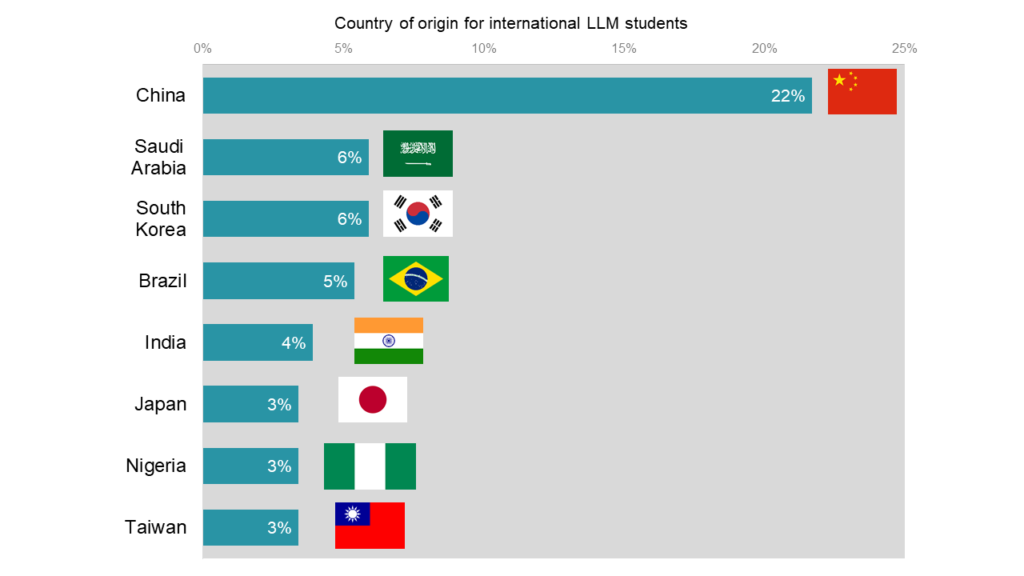
Because a JD degree or international equivalent is required for admittance to LLM programs, most LLM students are somewhat older than the typical law student. The majority (58%) of LLM students are between the ages of 26 and 40. Fifteen percent are over 40 and 28% are 25 or younger. LLM students are somewhat more likely to be women, which is in keeping with current trends toward slightly more female law students than male law students.
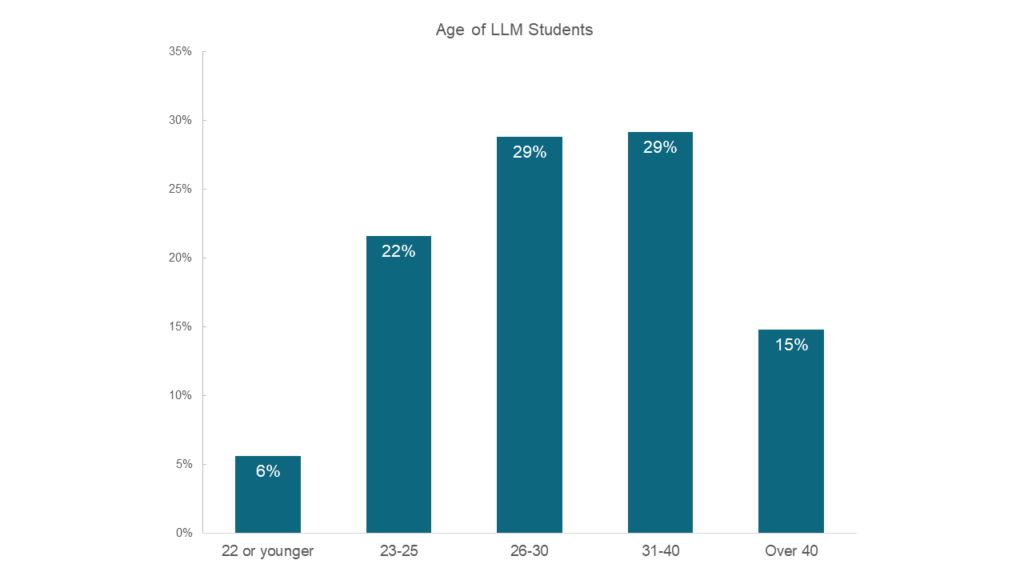
Satisfaction
In general, LLM students are satisfied with their law school experience. If given the chance to start over, most (78%) would choose to pursue a law degree and most (85%) would probably or definitely attend the same law school they are now attending. Nearly half (46%) rate their experiences as excellent, and another 38% rate their overall experience as good. Only 3% of LLM students describe having a poor experience. These data suggest that LLM students see their current degree program as a good investment. Future LSSSE reports will delve deeper into how LLM students engage with the law school experience and how satisfied they are with specific features of their programs.


Law Library Usage and Satisfaction
Learning to find, analyze, and use high-quality legal information is a core goal of a legal education. The main LSSSE survey gathers information about student satisfaction with library services while the optional Law Library module provides a wealth of details about how students interact with library resources as they develop information literacy skills. Here we will provide a small sample of survey results focusing on which library functions students use and how satisfied they are with core library teaching functions.
Teaching Functions
The first section of the library module asks students about three key library teaching functions:
- Legal research classes/presentations/programs the Library staff has held
- Interactions with librarians where legal research skills are addressed (at the reference desk, individual meetings, and virtual reference)
- Research guides compiled by Library staff to assist students in legal research
Students are asked about their experiences with these three functions of their law libraries by selecting one of the following options:
- Very unsatisfied
- Unsatisfied
- Satisfied
- Very satisfied
- Unsure whether my law library offers this service
- Not used but aware of service
This format allows us to measure not only satisfaction with each service but also how many students use the service or are at least aware it exists.
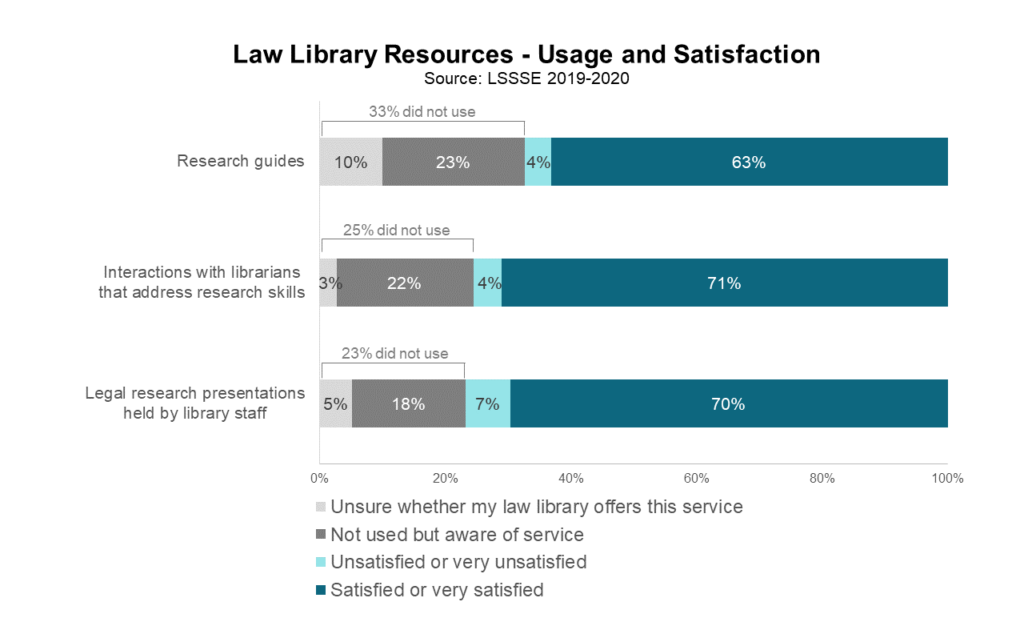
Legal research presentations held by library staff are the most used resource, with only 23% of students saying they either had not used them or were unsure whether they were offered at their library. Students are largely satisfied with these presentations, with about ten satisfied students for every dissatisfied one. Students are even more satisfied with interactions with librarians that addressed legal research skills: 75% of students had these interactions, and among those students, 94% were satisfied or very satisfied with the interaction. Of the students who had not had an interaction with a librarian that addressed research skills, most are at least aware that this service exists at their law school. Research guides were the least used library resource. A full third of students had not used research guides during the school year, with about ten percent of students unsure whether their library even offered this service. Again, however, students who had used research guides are overwhelmingly satisfied with them.
Usage Rates
Though many university libraries have reduced their physical presence in favor of more virtual offerings, law libraries remain a notable exception, likely due to the intense reading loads of their student patrons. A full 96% of LSSSE respondents have used their law library as a study space in the past year, and 94% have used their law library’s collaborative spaces. Nearly all law students (94%) used online resources, and another 88% used print resources. About three-quarters of students received reference assistance and used circulation services, and about half asked for interlibrary loan assistance. Thus, overall usage rates of law library resources are quite high.
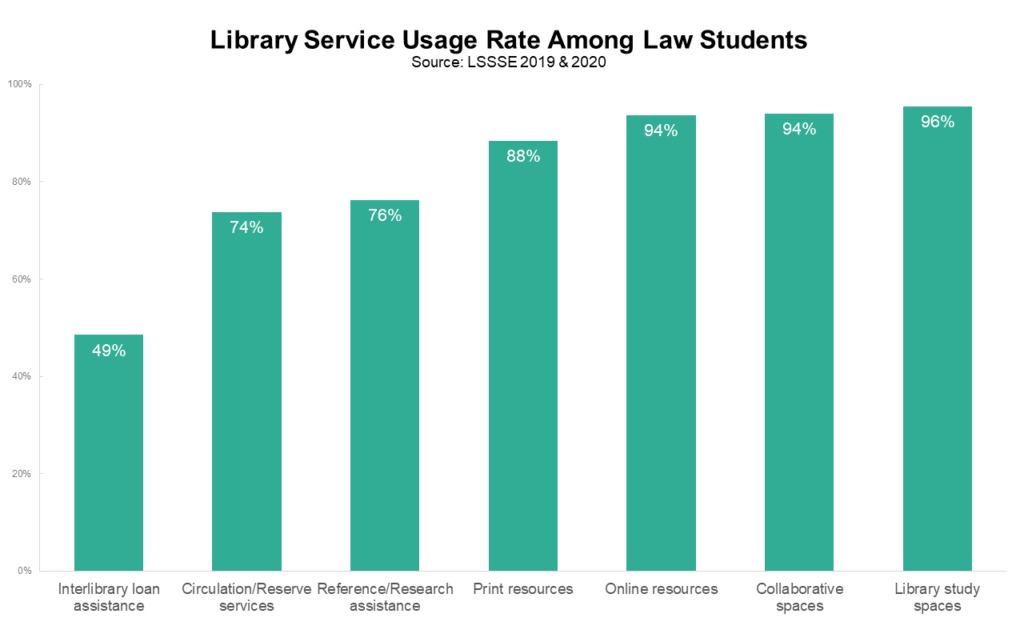
Satisfaction
Among students who used each service, satisfaction is generally high. The services that involve personal interactions are most highly rated; around 95% of respondents who used interlibrary loan, circulation/reserve, and reference assistance were satisfied or very satisfied. Students were somewhat less satisfied with their law library’s physical spaces, with around 18% of students expressing dissatisfaction with the library’s collaborative spaces and around 12% of students expressing similar negative opinions about their library’s study spaces. Students are more likely to be satisfied with online resources (96%) than with print resources (87%).
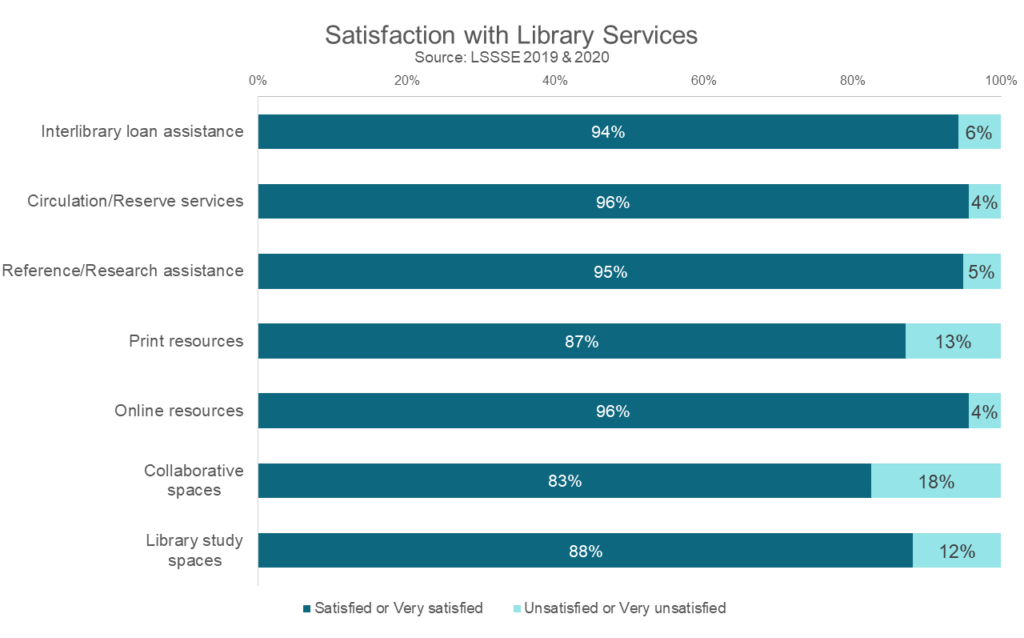
LSSSE results strongly suggest that law libraries are crucial to the law school experience. Nearly all students had used their law library in the previous year, and law students were generally quite satisfied with the core services they found there. Most students were pleased by their interactions with library staff and resources, although some students desired changes to their library’s collaborative spaces and study spaces. This suggests that law schools could invest somewhat more in physical aspects of the law library, rather than online ones, to increase student satisfaction. It will be interesting to see whether students interact with their physical and virtual law libraries in different ways during this odd year of social distancing and remote learning. Stay tuned for LSSSE 2021 results.
Guest Post: Beyond Enrollment: Why Motivations Matter to the Study of Legal Education and the Legal Profession?

Stephen Daniels
Senior Research Professor
American Bar Foundation

Shih-Chun Chien
Research Social Scientist
American Bar Foundation
The upheaval caused by COVID-19 pandemic might change everything we know about legal education. Reports in the legal media have speculated on the impact of COVID-19 on law school applications, enrollments, budgets and, ultimately, even survival. Depending on the timing, that speculation can run from the negative to the somewhat hopefully positive.[1] Some of the uncertainty comes from the disruption in the normal application to enrollment process – like the cancellation of in-person LSAT testing. More broadly, it surely comes from the truly unprecedented situation in which we find ourselves.
The uncertainty provides an opportunity – in fact, it may require us – to think critically about the homogenized aggregate numbers of applicants and matriculants we often see along with the broad environmental factors said to drive them. With just a few notable exceptions, most recently the 2017 AALS/Gallup surveys,[2] one is tempted to agree with the statement made almost a lifetime ago, “Vague notions, old myths, and thought-shrugging generalities are all we have to describe the raw material from which our lawyers come.”[3]
We need to think systematically about the variety of individual motivations or reasons that may help us understand those prized numbers. This means going beyond the following common idea that appeared recently:
[W]e could also be looking forward to another onslaught of law school applicants thanks to the economic downturn that’s been caused by the pandemic, just like what happened with the recession. ‘In the short-term, going to professional school – be it business school, law school or something else – is a good idea because it’s a refuge from an inhospitable job market, and the job market will be better three years from now.’[4]
An “escapist” explanation like this one is an old one,[5] but its vintage does nothing for its veracity or usefulness.
Such explanations strip any real substance out of the idea of motivation, telling us little about the decision to attend law school and nothing meaningful about the choice of law as a career – and ultimately, this is the important issue. The same is true for explanations that look for environmental causes not escapist in character. A recent variant not tied to escapism is the so-called “Trump Bump.” Here it is the idea that opposition to President Trump – and the overall results of the 2016 election – drove more people to law school than would have been expected. In fact, there may not have been much to it. The bump may have been as much a matter of marginal increases and wishful thinking as anything meaningful. It too is a motivation without real substance if we’re talking about the choice of a life-time career as a professional.[6]
What should we make of a profession that, apparently, is made up of people choosing it for short-term reasons of escape or narrow, time-specific political reasons? Or maybe law school is something akin to Marine Corps training that fundamentally changes the varied lives of the recruits into a singular entity with a distinct mission.
Understanding the motivations that underlie aggregate figures is important for two central reasons in addition to any others. The most immediate and most obvious is enrollment. Law schools must have enough students and the accompanying tuition dollars to keep the doors open. All else of importance depends on this and at some points in time the need for students is more urgent. An article reporting on some of the 2017 Gallup/AALS findings opened by noting the sharp decline in after 2010 in the numbers of people interested in law school and saying that “legal education leaders were posing questions that simply could not be answered definitively: Why is this happening? When will it end? Can we do anything to stop it? … What motivates undergraduates to attend law school or deters them from attending?”[7] Important as these questions are, they are just a beginning.
The more far-reaching reason goes to the role of law schools as the gatekeepers to the profession.[8] They are key in shaping what the profession will look like, what it will be, and even what it will do. Law schools do so through the curriculum, pedagogy and the socialization process – and they do it with the people who choose to attend. Paying attention to general factors in the environment without a good sense of the varying motivations involved in the decision to attend law school is insufficient for performing that role well. That is, unless one is prepared to think those variations – the why, the who, and the interaction of the two – are irrelevant. That the substance of the raw material – beyond LSAT scores and GPAs – is irrelevant so long as the supply chain keeps moving. Literatures in psychology and on organizations suggest that motivations can be important for understanding the outcomes of legal education, especially graduates’ career aspirations. That substance is not irrelevant if we care about the nature of the legal profession and the role it plays or should play in our society.
 In short, motivation should not be simplified to provide just so explanations for law school application or enrollment trends. It is time to look more closely at the variations in and the complexities and dynamic components of motivation. This includes topics like shifts in motivations in response to changing environmental conditions or the possible links between particular variants of motivation and career aspirations or how such inclinations may be changed by the law school experience.
In short, motivation should not be simplified to provide just so explanations for law school application or enrollment trends. It is time to look more closely at the variations in and the complexities and dynamic components of motivation. This includes topics like shifts in motivations in response to changing environmental conditions or the possible links between particular variants of motivation and career aspirations or how such inclinations may be changed by the law school experience.
Some students may just want to join and prosper in the hierarchical legal profession, but others may want to use their legal training and position to change the world. But perhaps more importantly, many may think they want the latter but end up pursuing the former. Do motivations vary depending on one’s characteristics or background? In the deeper past this question may have been easier to address since law students were almost all white and male and from relatively affluent backgrounds, but no so today with a much more diverse student body. What difference, if any, do such changes make?
The earliest motivation studies go back to the 1960s and 1970s,[9] when the legal education landscape looked very different than today. There were fewer law schools but depending on the year chosen for comparison not necessarily fewer students than today and a decidedly non-diverse student body. This means many of their findings may not be all that relevant now, but some are (and that’s a topic for another post).
Perhaps most importantly, the early motivation studies set the stage for later ones even if they did not literally use the same survey questions. All studies, from two 1961 NORC surveys to the 2017 AALS/Gallup surveys,[10] share an interest in a small but varied set of themes surrounding: making money; prestige and professional advancement; serving the public good; the influence of others, especially family; the intellectual side of the profession; independence; and a catch-all category for those with no substantive motivation like waiting out the poor job prospects in sluggish economy. All find that individuals have a mixture of motivations – some more intrinsic, others more extrinsic – with different degrees of importance or intensity.[11] There are some basic consistencies – money and prestige are always important; yet, so are motivations that speak to the public good and to the kind of career wanted. The picture is a nuanced one.
The extant studies, old and more recent, share something else. In addition to asking about motivation they also asked students a host of demographic questions about the students themselves and their family backgrounds. They remind us that the pool of people considering a career in law has changed over time and suggest that motivations may vary among the different groups making up that pool and change over time.
One source – a data set rather than a published analysis – went farther in asking law students numerous questions about their legal education and the type of law they would like to practice along with the setting in which they would like to work. It allows us to look for connections among motivations, backgrounds, law school engagement, and most importantly what a student hopes to do. Motivations become intelligible and meaningful to the extent they are connected to what students – with different backgrounds – hope to do and how well their law schools meet their expectations.
That source is a group of questions included in the 2010 LSSSE survey of law school students. In addition to the broad set of questions asked in the annual LSSSE surveys the 2010 survey asked students at 22 law schools to rate the level of influence of seven possible reasons for choosing to attend law school (reasons readily recognizably in light of earlier studies). From those schools 4,626 responded. Among other things, the survey found that among first year students, the most influential factor in the decision to enter law school was the desire to have a challenging and rewarding career (figure 1). The survey also found a relationship between student motivation and academic engagement.
Figure 1: Percentage of 1Ls who rate each factor "highly influential" in their decision to attend law school (rated 6 or 7 on a seven-point scale)
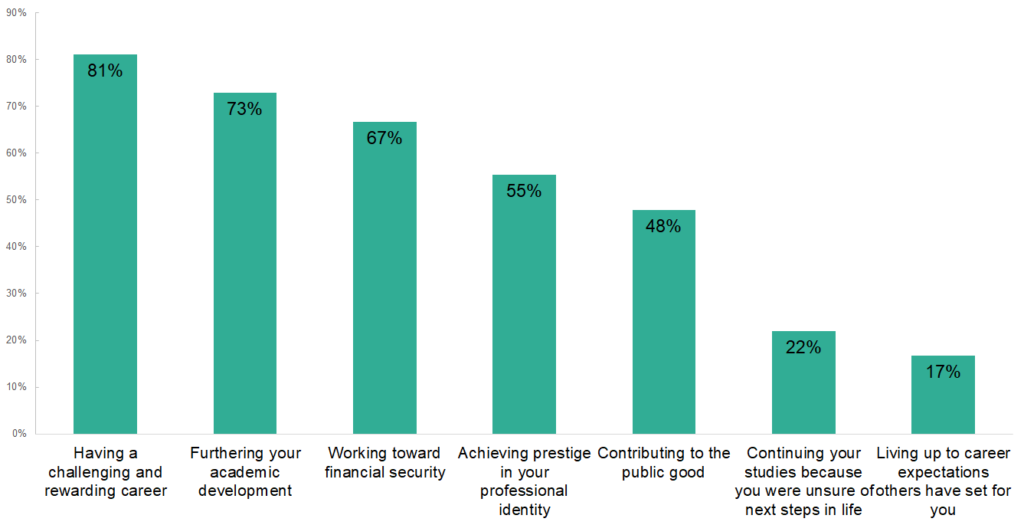
The 2010 LSSSE is important for another reason. It provides a fascinating snapshot at a critical moment in the contemporary history of legal education: the peak of greatest enrollment, immediately after which came the “great enrollment decline.” The 3Ls in the survey would have made their choice before the Great Recession hit and the 1Ls would have made their choice at a time when the recession was well underway. How might motivations and other student characteristics have differed between these two cohorts – one choosing in better times and the other in worse times?
By 2015 the decline ended and enrollments leveled-off – but at numbers not seen since the 1970s. Students starting this fall will have made their choice as the COVID-19 pandemic – along with its collateral damage – was unfolding, and 2020-21 3Ls would have made their choice in 2018, amidst a robust economy. Are the motivations different? Are the students different?
More interestingly, what would we find if we asked the exact same questions in the spring 2021 LSSSE survey as asked in the spring 2010 LSSSE survey?[12] Are motivations different in this changed world compared to those found in the 2010 data? Are the students different?
While we are working now with the 2010 data to address some of the questions above, we are also working with the LSSSE administrators to include those questions in the upcoming 2021 LSSSE survey. This will allow us to address not only differences at two points in time but changes in motivations, students, and students’ views of their legal educations. Doing so will help provide a fuller understanding of what may underlie students’ reasons to choose law as a career and how well law schools meet those motivations.
__
[1] Staci Zaretsky, “Should Law Schools Be Expecting Another Onslaught of Applicants Thanks to the Pandemic?” Above the Law, April 24, 2020, https://abovethelaw.com/2020/04/should-law-schools-be-expecting-another-onslaught-of-applicants-thanks-to-the-pandemic/; Karen Sloan, “Law School Applications are Down: Will COVID 19 Spur a Late Comeback?” Above the Law, June 3, 2020, https://www.law.com/2020/06/03/law-school-applications-are-down-will-covid-19-spur-a-late-comeback/ : Karen Sloan, “Law Schools See Late Application Boost After Spring COVID 19 Slowdown,” July 14, 2020, https://www.law.com/2020/07/14/law-schools-see-late-applicant-boost-after-spring-covid-19-slowdown/.
[2] See Association of American Law Schools and Gallup, Before the JD: Undergraduate Views on Law School (2018); American Association of Law Schools, LSAC and Gallup, Beyond the Bachelor’s: Undergraduate Perspectives on Graduate and Professional Degrees (2018); Jeff Allum and Katie Kempner, “Inside the Minds of Future Law School Grads: Some Findings from Before the JD,” 87 The Bar Examiner (Winter 2018-1019), https://thebarexaminer.org/article/winter-2018-2019/inside-the-minds-of-future-law-school-grads-some-findings-from-before-the-jd/.
[3] Louis Toepfer, “Introduction,” in Seymour Warkov and Joseph Zelan, Lawyers in the Making (1965); at xv.
[4] Zaretsky, supra note 1, quoting Bernie Burke; see also Sarah Zaretsky, “Law School Applications on the Rise Thanks to Bad Job Market: Law Schools Will Happily Take Applicants’ COVID cash,” Above the Law, July 14, 2020, https://abovethelaw.com/2020/07/law-school-applications-on-the-rise-thanks-to-bad-job-market/.
[5] On escapism, see Barry Boyer and Roger Cramton, “American Legal Education: An Agenda for Research and Reform,” 59 Cornell Law Review 221, 253 (1974); Robert Stevens, “Law Schools and Law Student,” 59 Virginia Law Review 551, 616 (1973).
[6] Stephanie Francis Ward, “The ‘Trump Bump’ for Law School Applicants is Real and Significant, Study Says,” ABA Journal, February 22, 2018, https://www.abajournal.com/news/article/the_trump_bump_for_law_school_applicants_is_real_and_significant_survey_say; Karen Sloan, “Forget the ‘Trump Bump:’ First-Year Law School Enrollment Dipped in 2019,” December 12, 2019, Law.Com, https://www.law.com/2019/12/12/forget-the-trump-bump-law-school-enrollment-dipped-a-bit-in-2019/.
[7] Allum and Kempner, supra note 2.
[8] See Boyer and Cramton, supra note 5, at 224.
[9] See Warkov and Zelan, supra note 3; Leonard Baird, et al., The Graduates: A Report on the Characteristics and Plans of College Seniors (1973); Stevens, supra note 5.
[10] See Warkov and Zelan, id; AALS/Gallup, Before the JD, supra note 2.
[11] Intrinsic motivation refers to the desire to expend effort based on interest in and enjoyment of the task or effort itself – like a motivation driven by the intellectual side of things. In contrast, extrinsic motivation refers to the desire to conduct certain activities to obtain outcomes external to the task or effort itself, such as rewards or recognition – like money or prestige.
[12] See Benjamin Page and Robert Shapiro, The Rational Public: Fifty Years of Trends in Americans’ Policy Preferences (1992), 39: “question wording matters … The only safe way to identify opinion change, then, is compare answers to identical survey questions.” (emphasis in the original)




